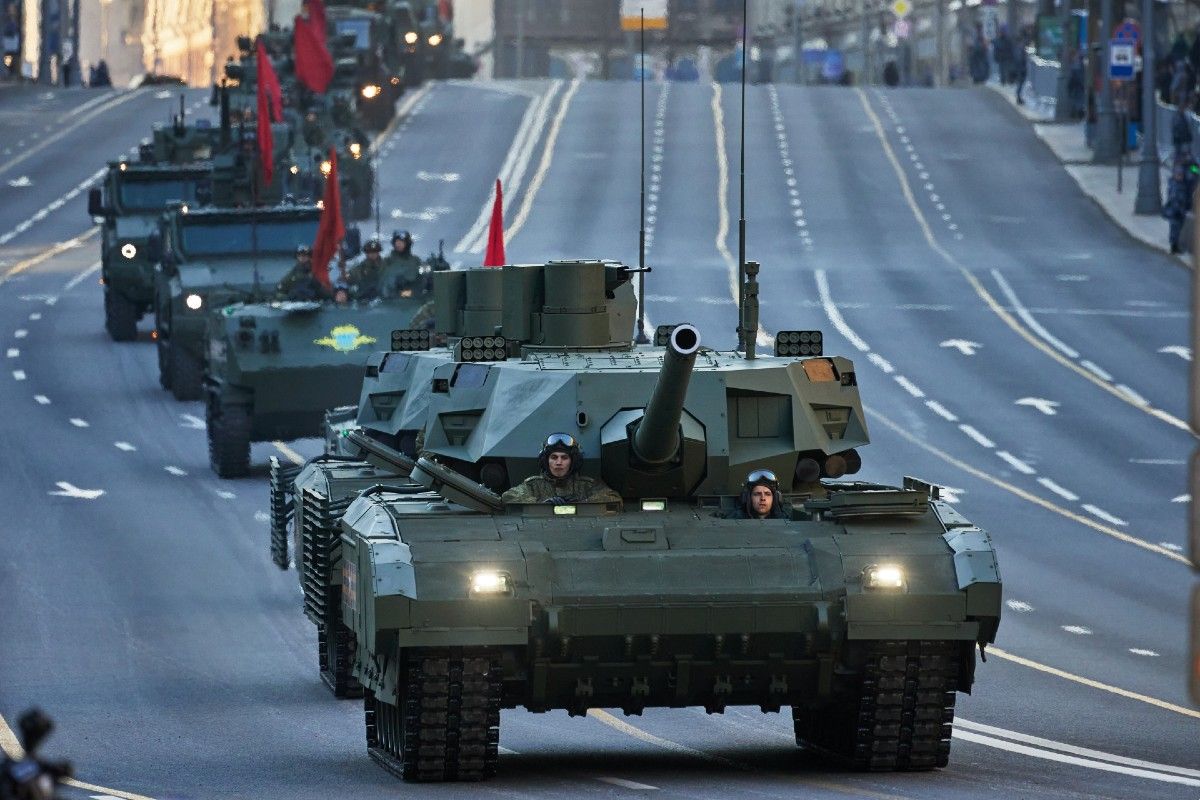How Russia's New T-14 Armata Tanks Compare to U.S. Abrams
Russia's hailed T-14 Armata main battle tanks have arrived in Ukraine, Russian state media reported on Tuesday, with Kyiv set to receive the promised U.S. M1 Abrams tanks.
Moscow has begun using the latest Armata tanks to fire on Ukrainian positions, Russian state-run news agency, Ria Novosti, reported. Citing a source close to the matter, the agency added the T-14s had not yet participated in direct combat but had been fitted with enhanced anti-tank ammunition protection.
Russian state media has long praised the "breakthrough" T-14, though some Western intelligence assessments have poured cold water on the possible capabilities of the new main battle tanks.
The British Defense Ministry previously suggested in mid-January that Russia was considering deploying a "small number" of the T-14s to Ukraine in what it described as a "high-risk decision for Russia."
The 11-year development program for the T-14 Armatas "has been dogged with delays, reduction in planned fleet size, and reports of manufacturing problems," the British Defense Ministry wrote on Twitter on January 19, 2023. Its use in Ukraine would likely function as propaganda, the ministry added, with few T-14s available for use and its commanders "unlikely to trust the vehicle in combat."
A Russian T-14 Armata tank participates in a Victory Day Parade night rehearsal on Tverskaya street on May 4, 2022 in Moscow, Russia. Moscow's troops have started using the Armata tanks to fire on Ukrainian positions, a Russian state news agency reported. Oleg Nikishin/Getty Images
Later in January, the U.K. Defense ministry said Russian forces "were reluctant to accept the first tranche of T-14 allocated to them because the vehicles were in such poor condition."
This comes days after U.S. Defense Secretary Lloyd Austin said the U.S. had "expedited our M1 Abrams timelines to supply Ukraine with more armored capability in the coming months."
Speaking at the Ramstein air base on April 21, Austin said that the heavily armored M1 tanks that Ukrainian personnel will use in their training would arrive in Germany "in the next few weeks."
The Abrams, which can weigh more than 73 tons, was described by U.S. President Joe Biden in January as the world's "most capable" tank. Able to travel up to 42 miles per hour, with the top cross-country speed coming in at 30 miles per hour, the tracked M1 allows soldiers to "dominate their adversaries through lethal firepower, unparalleled survivability, and audacious maneuver," according to the U.S. Army.
Read more Kyiv trolls Putin with bird's-eye video of Kremlin as spy drones spotted Kyiv trolls Putin with bird's-eye video of Kremlin as spy drones spotted
But the 48-ton T-14, after it was debuted by Moscow in 2015, was called the "most revolutionary step change in tank design in the last half century," British newspaper The Telegraph reported in 2016, citing an internal British Defense Ministry briefing paper.
Work began on the T-14 in 2010, Ria reported, to develop a "fundamentally new next-generation tank."
"There are no foreign analogues to this tank, and all components are domestic," the news agency added back in February. It can travel up to 56 miles per hour on-road, and 43 miles per hour off-road, the Kremlin-backed news outlet reported.
The T-14, which can carry three crew members, features an unmanned, remotely-operated turret design and what Russian state media has called an "isolated armored capsule for the crew."
"For the first time, a fully automated, digitised, unmanned turret has been incorporated into a main battle tank," the briefing paper obtained by The Telegraph read. "And for the first time a tank crew is embedded within an armoured capsule in the hull front," the internal memo added.
Russian state media has also reported the T-14 has the potential to be fitted with a 152mm-caliber gun, which would be larger than the 120mm main armament of the M1 Abrams. The T-14's standard primary gun is 125mm, and is also fitted with a 12.7mm anti-aircraft machine gun. Both the M1 and the T-14 have 7.62mm machine guns.
The Armata is "deliberately" less armored than the M1 Abrams, according to Ria Novosti. Its Russian engineers "relied not on making the tank heavier with powerful armor, but on the use of active and passive protection."
The T-14s "are more sophisticated and capable than older Russian tanks, but I don't see them as 'game changers' for the Russians in Ukraine," Guy McCardle, managing editor of Special Operations Forces Report (SOFREP), previously told Newsweek.
Russian state media reported in 2019 that the T-14 had been designed to include a toilet within the armored protection of the vehicle.
Newsweek has reached out to the Russian Defense Ministry for comment via email.
Source: Newsweek


